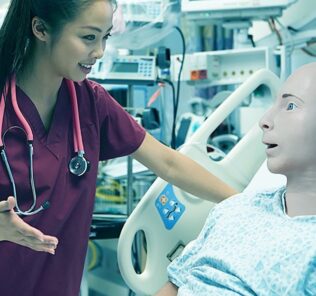How Clinical Simulation Helps Nursing Learners Strengthen Soft Skills
The practice of clinical simulation within nursing schools plays a vital role in providing experience in critical thinking and communication. The practice can also provide the “new nurse” with a more sound foundation. This HealthySimulation.com article highlights some of the challenges that nursing learners face when entering the field and shares how these two soft skills, in particular, critical thinking and communication, can help them mitigate these challenges. Above all, the article stresses the central role the nurse plays across medical teams.
One of the most challenging skills facing the new graduate nurse is critical thinking. This isn’t a skill that can be taught as a class in nursing school, but rather that comes with experience. New graduates simply don’t have that acquired experience yet. Another challenge facing nursing learners is how to communicate clearly and professionally among the healthcare team. This is especially true as, often, this will include professionals who the nursing learner has never encountered before.
Still, the most intimidating communication situation involves the provider or surgeon. Further, nursing learners can become quickly overwhelmed when they realize there are many different members of the team that must share information. Ultimately, the nurse is central to that team.
Sponsored Content:
Luckily, the clinical simulation team can provide critical thinking practice using healthcare simulation while still meeting the stated clinical learning objectives of the faculty. Each simulated patient experience comes with some level of critical thinking in order to progress through the event. In each scenario, from the basic to the complex, the simulationist can incorporate opportunities to for the learner to critically think.
By using lab values that must be evaluated by the learner, there exists the opportunity for them to recall normal values, evaluate the significance of abnormalities, and communicate this to the provider. There may also be a decline in the condition that requires them to call respiratory for breathing treatments. For example, maybe the simulated patient needs to go to radiology but is unstable. The nurse cannot make the decision to hold the test but must seek guidance from the provider which requires a call and report of the situation.
The experienced nurse knows how to handle these events appropriately, but the nursing learner lacks the experience to prioritize tasks. These are all teachable moments that speak to the importance of critical thinking. Often during debrief, these are the moments that have the greatest impact as learners reflect on their performance.
Critical Communication Scenario Examples
Sponsored Content:
As another example, a scenario may incorporate a call from another unit to give a report on a new admission while the nurse is caring for a patient who is declining. This is a very real scenario in practice and one that a nursing learner will not experience in the clinical rotation (where he or she will be responsible for a limited number of patients).
In reality, a nurse has options including to: take a report, thereby taking attention away from their currently unstable patient; refusing to take a report, which would be unprofessional and erode interdepartmental relationships; or deferring to the charge nurse who may take the report instead. These types of decisions are commonplace across the practice of nursing, but nursing learners are not typically prepared to juggle several balls in the air at once.
In debrief, the “what-ifs” become the “a-ha” moments. Options can be discussed and explored so that the learner is able to draw on these simulated experiences when faced with similar scenarios later in practice.
One of the most frequent provider criticisms of nurses who are new to the field is their poor skills in clinical communication. In healthcare, the common method of sharing information concisely is through the Situation, Background, Assessment, and Recommendation (SBAR) format. Across healthcare simulation education, simulationists may brush over the topic of clinical communication to focus more on the stated clinical objectives of each scenario.
Instead, professional communication should be incorporated into the learning objectives and discussed during debrief. Frequently in nursing simulation scenarios, lab results are given over the phone and are then reported to the “physician” by the learner. The learners will often fail to write down values, fail to notify the physician, or fail to use a standardized approach (such as SBAR).
Then, during debrief, the facilitator can emphasize this communication barrier and the learner has a chance to reflect on how they can improve the next time. In the clinical setting, nursing learners are generally not granted the opportunity to give a report to a provider. Expecting them to be able to do so as a new graduate is unrealistic.
Additional Nursing Simulation Communication Scenarios
Other types of communication scenarios may involve an angry family member, a disgruntled patient, or a refusal of care by a patient. With a focus on diversity, equity, and inclusion, healthcare simulation educators must provide an opportunity for learners to reflect on implicit biases when faced with uncomfortable or unfamiliar situations.
By incorporating these experiences into clinical simulation, the learner can practice difficult conversations in a safe environment. During these types of simulations, learners will also be given the opportunity to call “time” if they are truly overwhelmed. This will end the scenario if necessary. During debrief, observers can then help brainstorm and discuss methods with the facilitators or faculty for handling such situations in clinical practice.
Overall, high-quality clinical simulation in nursing education is increasingly valuable as clinical experience opportunities dwindle. Nursing simulation gives faculty and healthcare simulation educators a greater opportunity to control the quality of the clinical experience.
Clinical days in the hospital do not always provide an ideal learning environment. Learners may be told to “stand over there and watch” or can be ignored altogether by a nurse preceptor (who may be overwhelmed and inexperienced as well). The healthcare simulation setting thereby allows for evidence-based education to be presented and for the nursing learner to understand the rationale for the standard of care.
Nursing graduates will go on to practice in settings that may be very different from their clinical settings. Also common, local clinical sites may not mirror best practices or standards of care. In clinical simulation, learners experience a hands-on, realistic practice that they can draw on in these situations.
Critical thinking and communication skills cannot be expected to materialize without a deliberate opportunity to practice them during academic training. In conclusion, clinical simulation is a viable solution to bridge this graduate-to-professional nurse gap.
Learn More About Nursing Simulation
Tina Hayes, MSN, RN, RNC-OB is a nurse with over 20 years of experience in practice and staff development. She is certified in Inpatient Obstetrics and Electronic Fetal Monitoring and is an instructor of Advanced Life Support in Obstetrics. She is also an instructor of BLS and ACLS.
She began her career in general medical/surgical nursing and became an obstetrics nurse in 2004. She has held positions as a staff nurse, charge nurse, preceptor, nurse manager, and clinical educator. Hayes became involved in simulation while working as a nurse manager and training staff in postpartum hemorrhage response and drills. The visual enhancement provided by simulation and the benefit of hands-on practice was inspiring.
She moved into a full-time position as a simulation educator in 2017 at Northeast Georgia Medical Center where a large educational and simulation center was built in 2019 to support a new Graduate Medical Education program. She served as the obstetric subject matter expert in simulation and participated in the development of a mobile simulation unit at NGHS, making simulation education available to areas throughout northeast Georgia.
Hayes moved to Miami, FL in 2022 and currently works as a Simulation Educator at Miami University’s School of Nursing and Health Studies.
Sponsored Content:


















